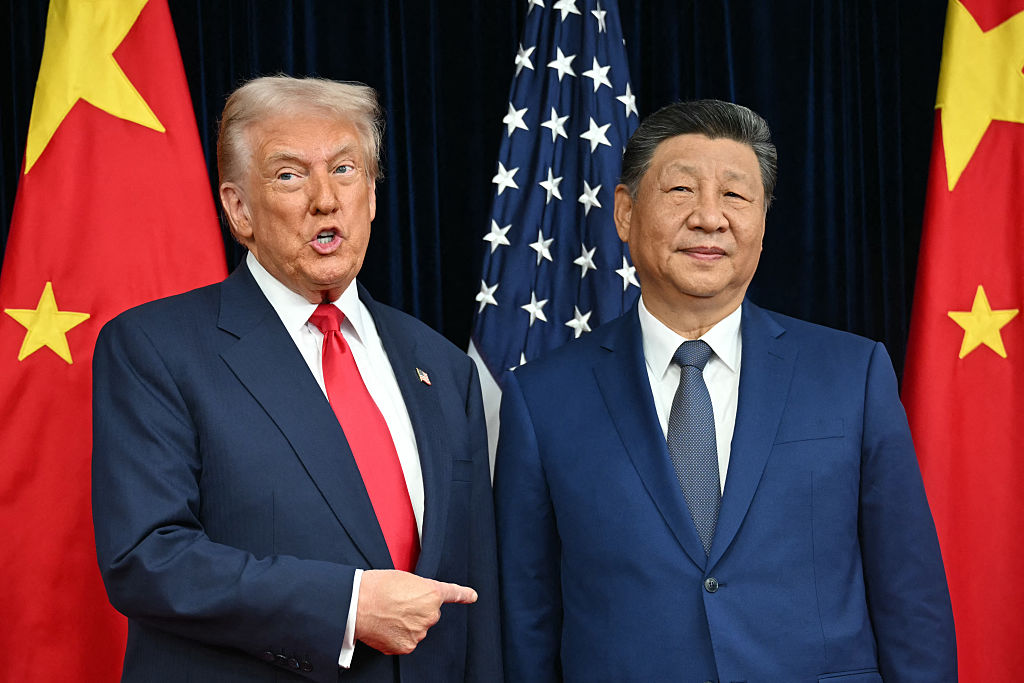US-China trade talks: “amazing” meeting yields tariff truce
Trump hailed a “12/10” meeting with China’s Xi Jinping on Thursday. But despite progress on rare earths and tariffs, details about TikTok’s ownership are still unclear.


Trade tensions between the US and China appear to be easing, as US president Donald Trump and Chinese counterpart Xi Jinping met in South Korea this week.
Negotiators from the two superpowers had earlier agreed on a trade framework, elements of which were confirmed by the two leaders when they met on Thursday.
Trump had previously threatened to impose 100% tariffs on imports from China in response to Beijing tightening export controls on rare earth materials (which are essential for many high tech products, including self-driving cars and artificial intelligence). This threatened a return to the ratcheting up of tariffs between the two countries back in the wake of “Liberation Day”, which threatened to restrict global trade.
MoneyWeek
Subscribe to MoneyWeek today and get your first six magazine issues absolutely FREE

Sign up to Money Morning
Don't miss the latest investment and personal finances news, market analysis, plus money-saving tips with our free twice-daily newsletter
Don't miss the latest investment and personal finances news, market analysis, plus money-saving tips with our free twice-daily newsletter
But US-China trade looks set to get back on track after the two countries agreed to postpone commerce restrictions including China’s rare earth export controls, while Trump agreed to cut his additional ‘fentanyl tariff’ on imports from China from 20% to 10%.
According to Trump, this brings the overall tariff rate on Chinese exports to the US down from 57% to 47%, though calculations from the BBC suggest the previous tariff rate was 55%, implying a new overall tariff rate of 45%.
The deal, including China’s rare earth export stance, will be in place for one year but Trump told reporters on Air Force One that it will be “very routinely extended” and that “every year we’ll renegotiate the deal”.
Trump also called the meeting “amazing” and “a great success”. “On a scale of 0-10, with 10 being the best, the meeting was a 12,” he added.
China’s Ministry of Commerce also announced that a US rule dating from 29 September blacklisting exports to majority-owned subsidiaries of Chinese companies already on its proscribed entity list will be postponed. US treasury secretary Scott Bessent appeared to confirm this to Fox News on Thursday, saying: “Yes, we are going to be suspending that for a year in return for the suspension... on the rare earth licensing regime.”
“After a few weeks of tit-for-tat tensions… both countries came to an agreement on Thursday,” said Mali Chivakul, emerging markets economist at J. Safra Sarasin Sustainable Asset Management.
“The escalation was meant to demonstrate each country’s potential leverage as these measures would be impossible to enforce in the near term and could also cannibalise their own exporters,” Chivakul continued. “Postponing them keeps the threats alive but allows a more normal relation on the surface for near-term economic benefits.”
While the latest round of talks pulls the two superpowers back from the brink of prohibitively high trade barriers, a comprehensive trade deal is yet to be reached. And there was at least one glaring omission from the most recent round of US-China trade talks, as details of the future of TikTok in the US remain thin on the ground.
What has been agreed in US-China trade talks?
China’s Ministry of Commerce indicated on the morning of 27 October that an initial consensus on issues including an extension to the tariff pause had been reached.
Bessent told reporters discussions between the two countries have included a final agreement on ownership of TikTok in the US as well as a resumption of American soybeans by China.
“I would describe [the negotiations] as constructive, far-reaching, in-depth, and giving us the ability to move forward and set the stage for the leaders’ meeting in a very positive framework,” said Bessent.
Thursday’s meeting between Trump and Xi appears to have confirmed some of these details, but crucially, there has so far been no mention of TikTok.
TikTok is controversial because US lawmakers are concerned about the overwhelming popularity of a social media app owned by a Chinese company (ByteDance). According to Reuters, TikTok has 170 million users in the US – roughly half the country’s total population.
Last year, Congress passed a law mandating that ByteDance sells TikTok’s US arm by January 2025, but this has since been delayed until January 2026. At present, there is little clarity on how the proposed divestment is progressing.
Bessent indicated on 30 October that plans had been agreed pending Chinese approval. “I would expect that would go forward in the coming weeks and months, and we’ll finally see a resolution to that.”
The Chinese Ministry of Commerce issued a statement saying it had agreed “to work with the US to properly resolve issues related to TikTok”. But no details have been confirmed otherwise, and China’s approval remains the main stumbling block in terms of ByteDance divesting TikTok in the US.
The background to US-China trade talks
The latest round of tariff turmoil began on 10 October when Trump responded to Chinese plans to restrict rare earth exports from 1 December by threatening China with 100% tariffs.
Trump quickly backtracked from these comments, posting on his Truth Social platform on 12 October “Don’t worry about China, it will all be fine!”
In retrospect, some observers see elements of Trump’s own negotiating strategy in Beijing’s move to restrict rare earth exports (much as Trump has attempted to prevent the likes of Nvidia shipping AI chips to China).
“We had said that Xi was engaging in Art of the Deal Chinese Style,” said Nancy Tengler, CEO and chief investment officer at Laffer Tengler Investments. A Wall Street Journal article last week suggested that Xi has adapted his negotiating strategy specifically to counter Trump’s usual playbook of using the threat of economic sanctions to pressure partners into concessions.
“The rhetoric has softened over the weekend as negotiators have come to terms on a range of contentious points, which may set the table for Art of the Deal and Art of the Deal China,” said Tengler.
What would a US-China trade deal mean for your money?
As the world’s two largest economies, trade tension between the US and China has profound implications for the global economy.
Any thawing of relationships is generally good for the stock market, particularly risk assets, given the positive implications for the global economy and corporate earnings.
“Remember, it was the trade war between the two nations that sparked a major sell-off at the end of 2018 and this current spat has caused the most intraday volatility outside of April’s Liberation Day,” said Jay Woods, chief market strategist at Freedom Capital Markets.
Oil prices have also risen off the back of renewed optimism for US-China trade, which could be reflected in higher energy prices down the line.
Get the latest financial news, insights and expert analysis from our award-winning MoneyWeek team, to help you understand what really matters when it comes to your finances.

Dan is a financial journalist who, prior to joining MoneyWeek, spent five years writing for OPTO, an investment magazine focused on growth and technology stocks, ETFs and thematic investing.
Before becoming a writer, Dan spent six years working in talent acquisition in the tech sector, including for credit scoring start-up ClearScore where he first developed an interest in personal finance.
Dan studied Social Anthropology and Management at Sidney Sussex College and the Judge Business School, Cambridge University. Outside finance, he also enjoys travel writing, and has edited two published travel books.
-
 Boost for over 100,000 families on Child Benefit as new HMRC payment system rolled out
Boost for over 100,000 families on Child Benefit as new HMRC payment system rolled outThousands of households will no longer have to pay the dreaded High Income Child Benefit Charge through self-assessment
-
 Are you being haunted by the ghost of Christmas past? How festive cutbacks could boost your long-term wealth
Are you being haunted by the ghost of Christmas past? How festive cutbacks could boost your long-term wealthThe average family spends around £1,000 over the Christmas season. Here’s how much you could have gained if you had invested some of the money instead.